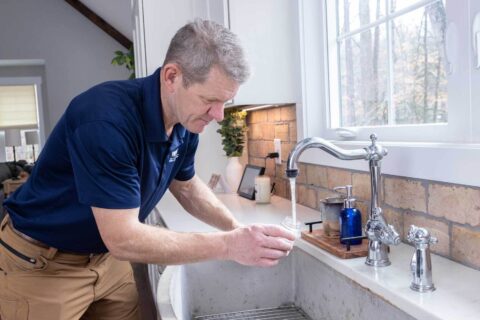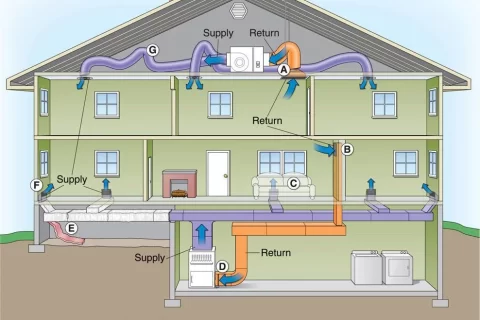Plumbing Upgrades for Accessible Home Renovations
Key Takeaways
-
These accessible plumbing upgrades significantly improve safety and usability. In addition, they create greater overall comfort for seniors homeowners and anyone with mobility issues.
-
By implementing safety features such as grab bars, anti-scald devices, and non-slip flooring, risks are lowered and safety requirements are met.
-
User-friendly features like touchless faucets, lever handles, and comfort-height toilets help to foster independence and make daily tasks easier.
-
Walk-in showers, adjustable showerheads, and reinforced walls make for a more accessible space and accommodate diverse mobility needs.
-
Anti-scald devices and easily cleanable, slip-resistant floor drains are examples of design features that improve health by preventing burns and falls while ensuring effective water drainage.
-
Combining contemporary aesthetics with universal design principles produces a useful and attractive lavatory space for every member of your household or customer base.
Aging-in-place renovations are less about reselling a house and more about living comfortably and easily in one’s own space.
Plumbing upgrades are an important component in this process, providing innovative, practical solutions to address evolving needs. Elements such as walk-in tubs, curbless showers, and touchless faucets increase independence and minimize risk while completing daily activities.
In homes where mobility is an issue, installing anti-scald devices and adjusting sink heights can help make them more usable to all residents. Installing lever-style handles or motion-sensor fixtures further reduces strain and increases independence.
These renovations make the spaces more functional, but they offer increased peace of mind to residents—and their families. With just a few accessibility-based plumbing upgrades, any home can fit aging-in-place priorities without losing any sense of style or homey comfort.
The tradeoff is that investing in thoughtful upgrades now can make a world of difference to maintaining long-term independence and quality of life.
Importance of Accessible Plumbing
Accessible plumbing can make a home much safer, more functional, and welcoming for aging homeowners. Bathrooms, especially, have their own special set of challenges, but with careful improvements, it’s still possible to create a space that is both functional and secure.
Toilet grab bars or shower grab bars provide sturdy support to prevent falls. Anti-scald devices, like thermostatic mixing valves (TMVs), greatly reduce the risk of accidental burns. These improvements not only lessen the dangers but foster a more welcoming environment for seniors and those with restricted mobility. Quality drainage systems and non-slip flooring remove dangers, particularly in moist environments, making a safe environment.
Comfort and usability should go hand in hand. Universal design Accessible plumbing improves everyday life through inclusive design that accommodates the needs of all users. Touchless faucets, lever handle faucets, and comfort-height toilets—several inches taller than standard models—make it simpler to use for people who have issues with mobility.
By including motion-sensor lighting, you’ll create visibility even during nighttime hours, improving safety 24 hours a day. These innovations help seniors stay independent longer, making them less dependent on friends, family, or caregivers for basic needs.
In addition to these short-term benefits, accessible plumbing preserves long-term goals of aging-in-place. More than 9 in 10 adults 65 or older want to age in place—stay in their current homes. With these upgrades, they’ll be better equipped to adapt to future needs.
Features such as voice-activated controls or adjustable fixtures address changing physical needs. Flexible designs create spaces that are welcoming for all ages, making them ideal for multigenerational households. Prioritizing safety, functionality, and independence, accessible plumbing helps make a home not just livable, but adaptable throughout one’s life and beyond.
Key Features of Accessible Bathrooms
Walk-In Showers and Bathtubs
Walk-in showers are a game-changer for anyone with mobility challenges. While traditional bathtubs pose a risk because they can be hard to step over, walk-in showers with curbless designs offer easy access. This type of arrangement is much more conducive to those who use wheelchairs or require support when ambulating.
A built-in, fold-down shower seat increases comfort and safety as you bathe. It reduces risk of falls by providing you with a secure place to rest. To add slip resistance, use textured tiles or tiles with slip-resistant coatings, which will help make the shower area even safer.
Grab Bars and Reinforced Walls
Grab bars are key for improving safety, such as near toilets and showers. Position them where it’s most important in reach of the toilet, in the shower, along the walls. This will ensure there’s consistent support at the times it’s most needed.
Bars between 1 ¼ and 1 ½ inches in diameter are ideal for gripping comfort. The walls behind them must be reinforced to keep them from blowing off under pressure. Stylish grab bars are now on the market that can enhance the aesthetics of the bathroom while providing the functionality that’s needed.
Proper installation by a professional will keep your grab bars in place and standing strong.
Adjustable Showerheads and Faucets
Adjustable showerheads for users of varying heights and needs allow for flexibility in a seated or standing position. Handheld options with long hoses make bathing a less physically demanding task. Faucets with easy-to-grab lever handles are easier to use, needing only the slightest pressure to turn on.
For even more convenience, touchless faucets not only create a more hygienic space, but are easier to use for all ages as well.
Anti-Scald Devices for Temperature Control
Anti-scald devices prevent burns by regulating water temperature and keeping it at a safe level. This can be particularly important for seniors or those with sensitive skin. Thermostatic mixing valves are a reliable option for maintaining a stable water temperature.
Routine maintenance checks ensure that these devices are functioning optimally, providing you and your family with peace of mind.
Practical Tips for Plumbing Modifications
-
Otherwise, install grab bars where they’re most needed to make it convenient and useful. Replace standard-height toilets with comfort-height models. Select flooring materials that are non-slip.
1. Assess Current Plumbing Needs
Begin by evaluating the existing plumbing system to identify areas that need updates for better accessibility. This could include checking for leaks, inefficient drainage, or outdated fixtures.
It’s important to consider the unique needs of everyone in the household. For example, seniors may benefit from higher sinks or touchless faucets for ease of use. Documenting current issues will help prioritize which modifications to address first, focusing on safety and usability.
2. Choose Non-Slip Flooring Options
Non-slip flooring is a key element in fall prevention. Not only do textured tiles and textured vinyl offer better slip resistance, but many styles are less expensive and easier to clean and maintain.
With regard to safety, simply keeping floors clean and dry goes a long way. Because non-slip materials come in a variety of styles, you can find one that seamlessly coordinates with your bathroom’s design aesthetic.
3. Install Comfort-Height Toilets
Comfort-height toilets are a great modification for seniors or anyone with mobility issues. These models are several inches taller, facilitating sitting and rising.
Raised toilet seats with handrails can additionally offer support to patients. As with anything, proper installation is critical to ensuring they don’t shift, posing safety threats.
Still, it’s worth trying out a range of heights to determine what might work best for the widest variety of users.
4. Ensure Proper Drainage Systems
Good drainage keeps water from accumulating, lowering the chance of falls. Floor drains in walk-in showers keep water runoff to a minimum.
Common in industrial environments, trench drains are great for managing large amounts of water in wide, open areas. Periodic and preventive maintenance helps keep basement drains free-flowing and leaves you with less to worry about.
5. Use Lever Handles for Easy Operation
Faucets and doors with lever handles are much easier to operate than conventional doorknobs. This feature makes them particularly useful for people with low hand dexterity.
There are stylish options that can complement your bathroom’s aesthetic while ensuring usability remains a focus. Proper placement not only makes them more accessible to all users.
Aesthetic Design Options for Accessibility
Blending Functionality with Style
Having an accessible bathroom doesn’t mean you have to give up on style and aesthetics. Innovative modern fixtures have revolutionized this space by creating smart designs that marry utility and elegance, allowing people to prioritize both utility and beauty.
For instance, grab bars can be made to serve as towel racks, offering support while adding to the aesthetic. Wall-mounted sinks and vanities provide a space-saving and wheelchair-accessible option while maintaining elegant aesthetics.
Creative design approaches such as curbless showers with frameless glass shower doors have an open and airy aesthetic. They enhance wayfinding throughout the space. Touchless faucets make it easier for people with decreased mobility to use faucets.
They’re available in aesthetic design options like matte black or even modern finishes like brushed nickel. By choosing fixtures that align with personal taste, homeowners can achieve a bathroom that feels uniquely theirs while being universally accessible.
Choosing Modern and Sleek Fixtures
Modern amenities such as comfort-height fixtures are both convenient and attractive. Their larger stature reduces stress in transitions from sitting to standing, which is the reason they have gained popularity across all age demographics.
Pairing these with durable, low-maintenance materials like vinyl flooring makes it more usable over the long term and easier to maintain. Energy-efficient fixtures, like LED vanity lights or low-flow showerheads, help improve sustainability while performing well.
By incorporating different styles, from sweeps to crickets, minimalist to modern farmhouse, designers give homeowners the freedom to choose features that align with their dream home aesthetic. Grab bars are located in all units to ensure safety.
You have aesthetic design options too—now popular finishes such as chrome or bronze can match your design decoratively and effectively.
Incorporating Neutral and Warm Colors
Color selections play a huge role in a bathroom’s overall feel. Cool, neutral tones such as beige, off-white, or pale gray open up the space, making even the tiniest spaces feel airy and expansive.
Incorporating warm accents—like pastel yellows or earthy browns—would help foster a more approachable environment for all users. A palette that pairs neutral walls with warm-colored accessories creates a win-win between accessibility and comfort.
Planning and Budgeting for Renovations
Evaluating Costs of Plumbing Upgrades
When planning for aging-in-place plumbing upgrades, knowing the costs can help save time and money. Here’s a breakdown of typical features, their estimated costs, and the benefits they bring:
|
Feature |
Estimated Cost |
Benefits |
|---|---|---|
|
Raised Toilet (17–19 inches) |
$200–$500 |
Easier, safer seating for those with mobility challenges |
|
Raised Toilet Seat |
$20–$100 |
Budget-friendly option to improve toilet accessibility |
|
Fold-Down Shower Seat |
$150–$500 |
Provides stability and comfort while showering |
|
Handheld Shower Head (6 ft.) |
$50–$200 |
Adjustable for seated or standing use; reduces strain |
|
Low or Zero Threshold Shower |
$1,000–$5,000 |
Improves safety by eliminating tripping hazards |
|
Motion-Sensor Faucets |
$150–$400 per fixture |
Hands-free operation minimizes effort and improves hygiene |
|
Nightlight Outlet Covers |
$10–$25 each |
Enhances visibility and navigation during nighttime |
Additionally, even minor upgrades can have a big impact on safety and comfort, ensuring your home remains stylish, yet accessible to all.
Hiring Professionals for Installation
This is especially true when upgrading plumbing for accessibility, which almost always necessitates expert assistance. Certified contractors and plumbers bring expertise that make sure installations follow safe practices and comply with building codes.
From Erik Listou, co-founder of the Living in Place Institute: It’s more about reforming what we already do, not revolutionizing it. For instance, contractors can add features such as grab bars into current spaces without extensive structural alterations.
Hiring experienced professionals saves you from making expensive errors and ensures the changes will last long-term.
Prioritizing Essential Modifications
Start with the renovations that will bring the biggest bang for their buck first. Consider upgrading to a comfort height or raised toilet.
You can further improve safety with a shower seat, handheld shower head, and low-threshold entry. If you’re on a tighter budget, focus on what you need most, such as a raised toilet seat or simple grab bars.
Maneuverability is especially important in areas such as bathrooms and kitchens. Allow a minimum of 5 feet by 5 feet of clear space to allow for safe movement.
Conclusion
Creating a home that enhances physical comfort and fosters independent living is achievable through smart renovations focused on aging-in-place. Whether it’s a home or a community center, plumbing upgrades can make any space safer and easier for everyone to use. Additions such as walk-in showers, grab bars and easy-to-reach faucets add accessibility and beauty. They make everyday life easier while never compromising on style.
Planning carefully and budgeting intelligently will help you make sure these changes serve your needs best. Adding a handheld showerhead makes a world of difference in accessibility. Similarly, increasing sink heights creates an instant impact in fostering a more user-friendly environment.
Whether you begin with minor changes or bigger projects, each makes your home a better place for all ages and abilities. Find out what is available today, and create a home that is ready for all of life’s ages and stages.
Frequently Asked Questions
What is aging-in-place renovation?
Living safely and independently in your own home as you grow older is essential for many people. These high demand renovations, including accessible bathroom designs and thoughtful user-friendly features, enable elderly homeowners to maintain their independence and comfortably navigate their daily routines for as long as possible.
Why is accessible plumbing important for aging-in-place?
Updating plumbing to create an accessible bathroom not only enhances safety but also ensures a comfortable bathing experience for those with mobility challenges. Features such as grab bars, walk-in tubs, and handheld showerheads reduce the risk of falls and promote ease of use in daily routines.
What plumbing features make bathrooms more accessible?
Important new features in accessible bathroom designs include walk-in showers, lever-style faucets, raised toilets, and anti-scald valves. These bathroom accessibility enhancements not only improve safety but also make spaces easier to use for everyone.
How can I make plumbing modifications without sacrificing style?
Select discreet grab bars and low-profile fixtures for your accessible bathroom design, ensuring a comfortable bathing experience while maintaining a stylish and functional bathroom space.
How much do plumbing upgrades for accessibility typically cost?
Cost varies on a per-project basis, with the extent of work determining overall costs. Noninvasive upgrades, such as the installation of grab bars for bathroom accessibility, begin at about $100. Major bathroom renovations, like the installation of walk-in tubs for elderly homeowners, can cost between $2,000 and $10,000, depending on the facility.
Are there financial resources available for accessibility renovations?
Are there grants, tax credits, or low-cost loans available to assist with the cost of bathroom accessibility upgrades? Explore your local, state, and federal programs and nonprofit organizations for help.
How do I plan for aging-in-place plumbing renovations?
Begin with the understanding of your priorities for bathroom accessibility. Collaborate with a licensed plumber who specializes in accessible bathroom design to ensure a functional bathroom environment.


